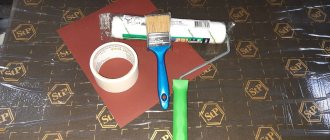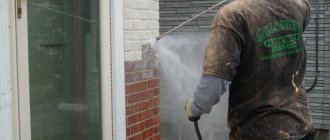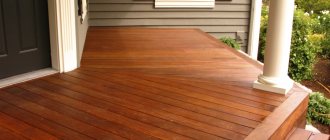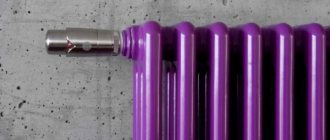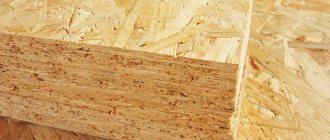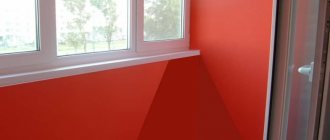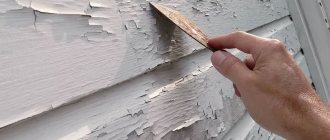How to paint a heating radiator: choosing paint and tools
Before you begin the main stage of work, you need to prepare. First, let's prepare soft brushes, which should be small in size and of two types - straight and curved. The straight brush is intended for painting external, easily accessible areas, and the curved brush is for painting the rear and internal surfaces of the radiator.
Which paint to choose
The main role in this work is played by paint for radiators, which can be of the following types:
- water-dispersed;
- alkyd;
- acrylic;
- oil
Any paint for heating radiators must be resistant to abrasion, withstand high temperatures (up to 100 degrees) and not release toxic compounds when heated. According to these parameters, the above options differ significantly from each other. For example, water-dispersion paints do not have an unpleasant odor and dry quickly, but this type of coating is less resistant to abrasion than others, meaning it will have to be renewed more often.
Acrylic paint contains a chemical solvent, so when used, an unpleasant odor is released, which takes a long time to ventilate from the room. The advantages of this coating are high abrasion resistance and an attractive glossy appearance.
Alkyd paint for radiators also has an unpleasant odor, but is in high consumer demand due to its high abrasion resistance and a huge range of shades. In addition, the smell from modern building materials is not so strong.
As for oil paint, it is being used less and less as a coating for radiators and pipes. The reason for this is the unpleasant odor, long drying time and difficulty in applying an even layer.
How to paint radiators is up to you, but it is best to use alkyd paints from well-known manufacturers. You just need to choose the appropriate coating color.
Paint requirements for radiators
Let's start with the fact that heating radiators are devices that emit fairly high thermal energy. Hence the basic requirements for paint:
- Increased heat resistance. Experts recommend paints that can withstand temperatures not lower than +100C.
- High resistance to various aggressive environments.
- Resistance to abrasion.
- Safety in terms of effects on the human body. Simply put, complete absence of toxicity.
So, back to the question: what paint should I use to paint radiators? Currently, manufacturers offer three main types.
Enamels based on acrylic components. This type is produced on the basis of solvents of organic origin. That is why, when painting, the paint releases a peculiar pungent odor that quickly evaporates. But the end result is a durable film with gloss that forms on the metal surface. This paint lasts for a very long time. Alkyd type enamels. This is the most common type of radiator paint and is used by a large number of consumers. Its advantages are resistance to abrasion and very high temperatures. Let us add that this type has a huge color palette. However, when dyeing, a strong odor is released that lasts for several days. Some alkyd paints emit a slight odor when heated, so it is worth following the recommendations of specialists when purchasing. Water-dispersed species. All experts agree that these paints are the best choice. Firstly, they do not emit odors, and secondly, they dry quickly
The only thing you need to pay attention to when purchasing is the labeling. The label of the jar must contain the inscription “for painting radiators.”
I would not like to bypass oil paints. Until recently, they were the ones most often used to paint radiators. But their popularity in the past was due to low quality characteristics.
As you can see, the range is not so small, but each consumer decides for himself what to choose. After all, each type has its own advantages and disadvantages.
Radiator paints and necessary tools
Many people believe that only the front part of heating radiators should be painted, but, unfortunately, this conclusion is erroneous.
Often, especially with Soviet batteries, rust spots begin to appear, and if they are not eliminated, the corrosion can spread further.
Good paint will help get rid of unwanted corrosion. To find out what paint to paint radiators with, you need to find out the characteristics of this product.
The purchased paint must be resistant to elevated temperatures, because radiators get very hot in winter, and maintain a natural color for a long time.
To choose the right paint and varnish material, you need to know what types are available for sale.
Acrylic paint has a natural color over a long period and is famous for not having a strong odor.
This option is well suited for painting radiators in winter, because you don’t really need to ventilate the apartment.
Alkyd paint has high temperature resistance and is therefore ideal for radiators. One of the disadvantages is the increased smell, so it is better to use it in the warm season, and not during the heating season.
There is another type of acrylic paint that is used in conjunction with a solvent. This material has good performance, firstly, the paint can be used without additional primer, and secondly, the coating has a good appearance and a glossy surface.
The well-known oil paint used to be a popular product, but with the development of the technological process it faded into the background.
This is the main list of paints and varnishes for cast iron radiators that can be purchased. For panel radiators, you can use aerosol paints (preferably auto enamel).
It is no longer fashionable to have white batteries, so do not be afraid to experiment with colors, the main thing is that the coating fits into the design of the apartment.
In a children's room, you can decorate radiators brightly, especially panel radiators, on which you can reproduce the whole landscape.
So how to paint radiators and in what style is up to you.
But it should be remembered that in order for the coloring material to adhere well, you must have a special tool, such as:
- sandpaper for pre-cleaning;
- a sharp object or knife to remove old paint;
- several types of brushes;
- small roller;
- unnecessary rags for cleaning the room.
This entire set will be needed for high-quality work and will help transform old and ugly radiators into a luxurious piece of furniture.
Why paint the radiator
In our harsh climate, we cannot do without additional heating sources. Of course, modern technologies do not stand still and more and more often systems are installed in homes, but the batteries we are used to can still be found in many homes.
It’s not easy without radiators in our climate. Such cast-iron, bulky structures are only appropriate in an industrial loft style.
Batteries, no matter how useful they are in the winter season, are constantly subject to criticism. Their design rarely fits into the interior of the room.
In addition to their bulky and awkward design, batteries are not easy to care for. Firstly, they perfectly collect dust, which needs to be periodically “swept out” using all sorts of tricks.
But periodically they need to be painted, which is even more difficult. Let's look at how to do this correctly step by step.
What paint is best to paint radiators?
Paint for heating radiators
In Soviet times, we covered traditional cast iron “accordions” MS-140 or steel heating radiators with two types of paints: oil and aluminum (silver). Somewhat later, pentaphthalic enamels PF-115 and the like appeared, and they also came into use. However, the listed coatings “smell” for a long time after application and lose their appearance quite quickly. As a result of almost annual renewal, the paint layer on cast iron batteries during the entire period of operation could reach 3-5 mm.
In the current conditions of a huge selection of various paint and varnish coatings, there are many painting materials intended for heating devices or simply hot surfaces, we will discuss them below. Now let’s list the compounds that are unacceptable to use as paints for radiators:
- oil (MA-25 and others);
- pentaphthalic (PF-115);
- nitrocellulose (NTs-132 and others);
- ordinary aluminum (silver);
- water-based paint for interior work.
All types of coatings from this list have one common drawback - they work under atmospheric conditions, that is, they are not heat-resistant. If you study the technical characteristics of the same PF-115, it turns out that the temperature range of its operation is from -50 to +60 ºС. It is not surprising that it very soon peels off the battery, whose temperature reaches 80-90 ºС. The same applies to chemically resistant nitrocellulose enamels with a coating that can be exposed to high temperatures.
Therefore, figuring out what paint to paint the battery with is quite simple. It must be heat-resistant, otherwise after a couple of heating seasons the same thing will happen. Below is a list of recommended coatings for batteries:
- alkyd;
- acrylic;
- silicone-aluminum;
- aluminum based on heat-resistant varnishes.
Which batteries can be painted?
It’s worth clarifying right away that painting heating radiators is not possible in all cases. First of all, it is advisable to perform this operation for cast iron radiators, a thick and uneven layer of paint on which not only spoils the exterior of the battery, but also greatly impairs the quality of heat transfer. The second type of batteries that can and should be painted are convectors, made in the form of a bent riser pipe with fins pressed onto it.
If you own modern models of radiators with aluminum sections, then it is better to abandon the idea of painting. Of course, you can paint it, but you will have to apply many layers of paint, and you are unlikely to achieve the expected effect. The fact is that the battery is painted with a brush, and this method is by definition worse than the factory one, so it is better to leave new battery models alone and, if necessary, cover it with a decorative screen.
Glossy or matte
When choosing paint for heating radiators, you need to choose what type of surface you want to get - matte or glossy. You need to choose based on the type of surface. The fact is that glossy paint emphasizes surface unevenness. Cast iron batteries are most often painted, but their surface is far from ideal. By covering it with a glossy composition, you will only emphasize its imperfection.
Matte compositions are better in this regard - they visually hide many irregularities. So this is a good option. But there is also a drawback: matte white paint quickly acquires a grayish tint. This happens due to the fact that dust and dirt get clogged into the pores, and they are wide in matte paint. This dirt is not washed out from there. The solution is a fresh coat of paint or painting in a color other than white. A smart choice is to match the paint to the color of the walls. From a design point of view, this is a better solution than white radiators.
If there is a pattern on a cast iron radiator, the gloss will emphasize and highlight it
There is another way out - to repair the unevenness of the radiator. This is done using metal putty, you can use automotive putty. First, old paint, rust and other contaminants are removed, then the surface is degreased and then all irregularities are sealed with putty. After it dries, use sandpaper with medium, then fine grain, and sand the surface until smooth. Then it is dusted, primed and painted. In this case, you can safely use glossy enamels for heating radiators. If the surface is leveled carefully, you will be pleased with the result.
Preparing radiators for painting
Before you start painting radiators, they need to be properly prepared. The fact is that if you paint an untreated surface, it will quickly lose its attractiveness. In addition, uneven places will protrude from under the painted layer. Over time, cracks will appear in these places.
Think about how to remove the old paint and how many consumables to purchase.
Removing old paint
There are 2 ways to remove paint:
- chemical solvents,
- wire brush.
A metal brush is inserted into the drill. This allows you to effectively and quickly remove the old coating. You can cope with the task perfectly with the help of washing solutions.
In order not to cause harm to health, it is necessary to follow safety precautions. It is recommended to wear a respirator to protect your respiratory tract. In addition, it is necessary to ventilate the room. The washing solution is applied with a brush to the entire surface of the battery. After this, it needs to be covered with film. After about an hour, the paint is removed with a spatula.
After the layers of paint have been removed, the surface must be completely cleaned. Try to keep it as even as possible. This stage takes time and effort, but it’s worth it, because the smoother the surface of the battery, the more harmoniously it will fit into the interior. After completing the preparatory work, the radiator should be degreased. You can use baking soda or white spirit for this. The next step is to apply an anti-corrosion primer.
There are situations when heating radiators need to be repainted, despite the fact that they are new. Before this, it is also necessary to carry out preparatory work. This includes removing dust and dirt, cleaning the surface with sandpaper and then treating with a solvent.
Removing paint using a remover:
How to paint a battery with your own hands
If the manufacturer's instructions do not indicate the possibility of applying the composition to old paint, then radiators require pre-washing, cleaning of the old paint layer, then priming and painting in 2 layers.
Work is carried out wearing protective glasses, a respirator and gloves.
Attention! A set of protective clothing is the best protection against harmful dust and chemicals. To protect the space around the radiator from accidental splashes, protect the surfaces with plastic film, cardboard or paper
Wiping the radiator
Use a brush or vacuum cleaner to remove accumulated dust and small debris.
All internal and external surfaces are thoroughly washed with detergent.
Remove the old paint layer in one of 3 ways:
- washed off with a chemical composition;
- removed mechanically using a drill and special attachments - brushes;
- soften the old paint with a hair dryer or a torch and remove it with a spatula.
Removing old paint
Chemical compositions for removing old paint (removal) are produced in the form of liquids or aerosols.
Important! When choosing a washing solution, pay attention to the composition: it should include components that prevent corrosion. The softened paint layer is removed with a spatula, or a rag will do. Removing paint without softening is done using a drill with a brush attachment with metal teeth.
After cleaning off the old paint, the surface is dusted: manually - with a brush, broom or vacuum cleaner
Removing paint without softening is done using a drill with a brush attachment with metal teeth. After cleaning off the old paint, the surface is dusted: manually - with a brush, broom or vacuum cleaner
The softened paint layer is removed with a spatula, or a rag will do. Removing paint without softening is done using a drill with a brush attachment with metal teeth. After cleaning off the old paint, the surface is dusted: manually - with a brush, broom or vacuum cleaner.
Sanding the surface
The surface of the radiators is sanded down to metal. This work can be done manually with sandpaper, but cleaning with a sanding machine is faster and better.
The dust-free surface is degreased if it is planned to paint with alkyd compounds - gasoline or white spirit; when painting with acrylic - acetone.
Primer
Before priming, flaws and large irregularities are puttied. Use metal putty designed for high temperatures (from 80 °C) (epoxy, automotive). The dried layer is sanded, dusted and degreased.
The primer is selected in accordance with the paint. Some manufacturers allow the use of paint diluted with water or solvent (5% by volume) instead of primer. This point should be described in detail in the instructions for the paint.
Coloring
To properly paint a battery, you need flute brushes: medium width with a straight handle and narrow with a curved handle.
Attention! Instead of a flute with a curved handle, you can make a pad from a piece of foam rubber attached to a wire. The wire is easy to bend at the desired angle, all hard-to-reach places are easy to paint
The primed metal base practically does not absorb paint.
Therefore, to avoid drips, take a little paint onto the brush and carefully distribute it over the surface in a thin layer.
The spray paint can is held vertically at a distance of 30 cm from the surface, and the composition is applied in a zigzag motion.
The painting sequence is the back surfaces from top to bottom, then the top, sides and internal parts, and lastly the front side and bottom of the battery.
The second layer of paint is applied over the dried first layer.
The need to paint the battery
There are times when painting a heating radiator is not just a whim of the owners, but really a necessity caused by certain factors.
So, the unit should be coated with a coloring compound if:
- purchased a new heating device. Many residents often have a question about how to paint a cast iron battery, since devices made from this material are often supplied unpainted;
- it was decided to carry out renovation work to update the interior of the premises;
- During operation, the heating device lost its normal appearance and turned into an outdated unit with peeling paint. This is especially true for traditional cast iron batteries, which were so popular in the last century.
In addition, it is very important that painting cast iron batteries does not in any way affect the heat transfer performance of the device, otherwise the performance of the equipment will significantly decrease.
Before preparing the battery for painting, you should remember that preliminary cleaning requires not only the old, but also the new battery, where there will always be some unevenness and dirty areas. The surface of the radiator must be thoroughly cleaned and then degreased.
- The old paint layer does not have any cracks or chips. This means that the previous painting of the heating radiators was done as correctly as possible, so in this case you can proceed directly to applying a fresh coating.
- If the surface of the battery has small areas with chipped and peeling paint, this means that these areas require sanding to obtain a smooth surface, and only then painting.
- Provided that the old coating has come off almost completely, painting radiators can only be done with serious preparatory work, which will require the use of a brush equipped with iron bristles, or a special washing solution with the addition of a certain amount of alkali.
It happens that areas exposed to rust appear on an old radiator. In this case, you can use various kinds of compounds that destroy this plaque, which are always available in any hardware store.
The modern construction market offers a wide range of paints and color schemes for them, so the choice of what is best to paint heating radiators usually depends on the preferences of the owners themselves.
However, when choosing a coloring composition, the following recommendations should be taken into account:
- the selected paint must withstand high temperatures (from 80 to 90°C);
- when choosing what paint to paint heating radiators with, you should understand that the composition must have a homogeneous structure and have good wear resistance so as not to lose its attractive appearance during operation;
- It is extremely important to make the paint resistant to the appearance of various harmful formations such as corrosion on the surface of the radiator.
Often, experts, answering the question regarding what and how to paint old batteries, advise using various types of enamels that meet all the above standards. At the same time, it is worth distinguishing the compositions according to their technical features.
After the surface of the battery has been properly treated, it is necessary to apply a primer layer to it so that the paint adheres better to the device.
If the paint is in normal condition without visible flaws, if there is only one layer (or two) and they lie flat, you can paint on top without removing the old coating. Only pre-treatment is required.
If you want to paint an aluminum or bimetallic battery, in which you are not satisfied only with the color, think carefully about whether it is worth spoiling the good coating. Maybe it’s worth covering the radiator with a screen in this case? And one more thing: if your radiators are under warranty, then after painting the factory (or seller) will refuse warranty repairs. Even if the reason is completely different.
If you want to get a color similar to the “factory” one, contact a specialized service station. They paint cars using the same technology. Maybe they will agree to paint your radiators
If you still need to paint an aluminum or bimetallic radiator, it is better to contact a specialized auto repair shop. Only they can help professionally. If you want to do everything yourself, you can use spray paint for cars. But with this option, there is a possibility that in those places where the radiator is often touched, the top layer will wear off, although it depends on the quality of the car enamel and the starting coating of the radiator.
If you still decide to use auto enamel, you need to work on hot batteries. And the hotter the better. Drying time at 130oC is 20 minutes, at 60oC - 40 minutes, and at 20oC - a month.
Important condition: during work and all the time while the paint dries, the window must be open, the doors to other rooms must be closed. Please wear a mask and gloves when working.
There are a lot of paints in cans, but you need to spray them on hot batteries
Everything around will have to be covered with paper and old rags. The can is a good thing, but it was almost turned in the wrong direction, and everything is painted to match the radiators... While working, keep the distance required for uniform spraying - it’s about 20-30 cm, but it’s written exactly on the packaging. And in general, even before purchasing, carefully read the instructions and recommendations for use. This way you will understand whether you can provide the required conditions for applying paint.
The order is the same: start with the inner surfaces, then go over the outer ones from top to bottom. Don't try to get the color perfect the first time. This is almost impossible, especially if the base color is white and some bright shade is applied to it. If you keep the stream in one place for too long, sagging and drips will appear. They are much more difficult to deal with than unpainted areas. It is better to apply one or two more layers after complete drying. The result will be better.
If you hold the stream in one place for a long time, or bring the spray can close, you will get a drop like this
Most often, old-style cast iron batteries need painting. It is definitely better to carry out the work after the end of the heating season: it will be safer for you and the painting will be of better quality. Then the order is:
- Completely and thoroughly clean the radiator from dust and dirt. This is done “dry” - with a vacuum cleaner and brush. If there are stains that cannot be removed this way, try water with detergent. Grease can be easily removed with dishwashing solutions or special acidic agents. This is far from the easiest and most pleasant process, but if you do not remove the dirt, there will be bumps and uneven spots under the paint. That’s why we clean it diligently. Let the battery dry.
- Then remove the top layer of paint with sandpaper. This is necessary to create a rough surface. This is the only way the paint will lay down evenly. You don't need to strip off the paint completely as long as it's smooth and free of cracks. Use fine sandpaper to roughen the surface, leveling out any minor imperfections if necessary.
- Wash off the dust with water and let the radiator dry.
- Coat everything with a primer compatible with your chosen battery paint and wait until it dries.
- Apply paint with brushes in several thin layers.
First you need to sand off the old paint, then wash off the dust and prime it
There may be two options here. If there is a factory sprayed enamel, it is better to use a can of auto enamel. If the paint is ordinary, the procedure is the same as for cast iron. The only difference is that it will be easier to paint the front panel with a roller rather than with brushes.
But in panel radiators you also need to change the color of the grilles. They will need to be painted with brushes. If there is rust on the gratings, they should first be cleaned, then treated with a rust converter, primed (with a composition with an anti-corrosion effect), and only then painted. The easiest way to buy all these products is at the car market - there are a lot of them in different packaging.
Read more: Phase control relay operating principle types marking adjustment and connection
Often the question is not how to paint, but how to remove old paint. There are several ways.
Mechanical
You can remove paint from the radiator using a drill and a special attachment. Mechanical methods also include treating the radiator with sandpaper. But this is a very long process that will take a lot of time and no less effort. If you don’t have a drill, you can pay to rent one and remove all the layers of paint down to the metal in a few hours. You will have to spend a whole day doing this manually, or maybe more than one - it depends on the size of the battery and the amount of paint on it.
Sanding a radiator requires a lot of patience.
Chemical
A special paste is often used to remove paint. It looks like a gel. Take a clean brush and apply the composition to all surfaces. If there is a lot of paint, the treatment must be repeated after 20 minutes (directly on top of the previous layer). Then it is recommended to cover the radiator with a film - this way the impact will be more intense.
These are paint removers and the result of their work
Thermal method
The paint coating on batteries is thermally resistant, but it also begins to peel off at certain temperatures. Therefore, in order to remove old paint from the radiator, it needs to be heated.
Preparatory work and process of painting batteries
To understand how to paint a heating radiator, you need to know the principle of the work being performed.
Like all types of construction work, the painting process begins with the preparation of batteries. First of all, it is necessary to eliminate contaminated areas and check the product for corrosion areas.
Swollen areas must be cleaned with sandpaper, and if rotten areas are found, they must be eliminated.
At the final stage, you should coat the radiator with a primer mixture, but you should only take into account the characteristics of the further material, because some types of paint and varnish products do not require a primer layer.
Several types of cleaning are used to clean heating devices from dirt and old paint. The first method is called chemical, and the second method (which involves using a special tool) is called mechanical.
To remove dirt chemically, solutions consisting of acids and solvents are used. You can prepare this mixture yourself or purchase it at the store.
To prepare the solution at home, you will need the following ingredients:
- sodium carbonate (soda ash), about one kilogram;
- slaked lime, in the same proportion;
- water, about five liters;
- large capacity, more than ten liters.
The solution is prepared as follows. Soda is dissolved in hot water, the water temperature is about 60 degrees, after which lime is added in small doses. This is done to prevent strong foam.
The mechanical method involves the use of a special tool or regular sandpaper.
The process is long and dusty, but to speed it up you can use a special drill attachment or use a grinder.
In this case, it is necessary to follow safety rules and carry out such work carefully so as not to damage the radiator.
Before starting work, you should set up a workplace, cover the floor with paper (or other material), protect the walls with a gasket (you can put a large sheet of cardboard), prepare the necessary tools.
Apply paint to radiators with a brush, preferably from top to bottom - this way there will be no drips. The layer should be thin and uniform. After the paint has dried, you need to apply a second coat.
The internal parts of the radiators must be painted first to avoid getting dirty in the process. Small parts and difficult places should be painted using a sponge or roller.
That's the whole principle of painting radiators.
Preparatory work
A high-quality result depends not only on the correct choice of material and painting. Careful preparation plays a huge role in this. To prevent the new paint on batteries from cracking, you should perform several manipulations with your own hands:
- Remove the old layer.
Using a hair dryer, you need to heat the old paint until it melts and begins to peel off. Then it can be removed with a spatula.
Remove the old paint layer with a spatula
If you don't have a hair dryer, use special paint removers. The entire battery should be covered with liquid, covered with plastic and left. Usually the corrosion process takes no more than an hour. After the specified period of time, the paint is removed with a spatula. This way you can remove almost all of the old coating, but in some places it will remain, so additional manipulations should be carried out.
Important! When using cleaning fluid, ensure the room is well ventilated and use personal protective equipment.
To remove residues, use a grinder or a screwdriver with special wire attachments. With their help, the battery can be stripped down to metal. If such a power tool is not available, then cleaning is done with a special brush with metal bristles or sandpaper.
Using a grinder with a metal nozzle, we clean the battery down to metal.
If there are rusty spots on the batteries, you must use a special liquid designed to remove rust. You can purchase it at any hardware store.
- Degreasing of metal.
This is done using special means: acetone, white spirit. You need to soak a rag in the liquid and thoroughly wipe the entire surface of the heating radiator.
Cover the battery with primer
- Primer coating.
At this stage, the battery is coated with a special anti-corrosion primer. It will prevent corrosion on the heating element. The adhesion of paint to the surface of the radiator will become better.
- Elimination of irregularities.
If the product has cracks, irregularities, or chips that need to be hidden, you will have to putty them. It is best to use automotive putty. After eliminating the defects, wipe the surface again and treat with a primer.
We putty the unevenness
Choice of paint for radiators. comparison table
To paint heating system elements, high-quality paint for heating radiators is used, which meets high requirements. It must be safe, resistant to overheating, cracking and fading. Experts recommend choosing the following types of paints for heating pipes and radiators:
| Types of paints and varnishes (paints and varnishes) | Types of surfaces | Benefits of paints | Disadvantages of paints |
| Oil paints | Cast iron | Affordable price, wide range of colors | Long drying time, strong odor, susceptible to yellowing, cracking and chipping |
| Acrylic enamels | Cast iron, steel, bimetallic | Virtually no pungent odor, high drying speed, attractive glossy shine, rich colors | High demands on the surface to be treated: thorough cleaning and preliminary priming |
| Water-based alkyd enamels | Cast iron, steel, bimetallic | Subtle chemical odor, color fastness | The presence of titanium white for resistance to elevated temperatures, which increases the cost of production |
| Alkyd enamels on solvents (organic) | Cast iron, steel, bimetallic | Withstands high temperatures, wide range of colors, affordable cost | Persistent chemical odor, tendency to yellow |
| Alkyd hammer enamels | Cast iron, steel, bimetallic | High protection of surfaces from damage, resistance to elevated temperatures, durability, affordable cost | Presence of a slight chemical odor that disappears when dry |
| Powder paints | Cast iron, steel, bimetallic | High strength and durability, resistance to temperature influences | The powder composition is applied using professional equipment in a special chamber |
| Silicone paints | Cast iron | Increased heat resistance, durability, wear resistance | High cost, pungent odor |
| Water-based paints | All types | No pungent odor, wide range of colors, high environmental friendliness and safety | High requirements for surface preparation - mandatory degreasing and priming |
| Serebryanka | Cast iron | High temperature resistance, low cost | Persistent chemical smell |
| Aerosol paints | All types | Wide range of colors, ease of application, affordable cost | Unpleasant smell |
Useful tips
You can do the job efficiently and beautifully yourself, you just need to take into account all the nuances and follow the rules.
Here are some more useful tips from the professionals:
- the painted radiator should not have drips - to do this, apply the paint in a thin layer and with smooth movements;
- It is better to paint the back of the heating device using a curved brush with a long handle;
- if a chemical method is used to clean radiators, then it is necessary to use personal protective equipment;
- After completing the painting work, the room must be well ventilated. If the work is carried out in winter, then you should use paints without a strong odor;
- pipes and hidden elements do not need to be painted, which will help preserve heat transfer;
- To understand which paint is best to paint, you need to study all the characteristics of the product.
Video:
There is nothing complicated in this type of work, therefore, you can paint the heating system yourself.
You just need to listen to the advice of experts, and your radiator will be as good as new.
If you play with your imagination and change the color of the radiators, they will become even better than new ones.
New shades of the restored battery should be chosen based on the interior of the room: if it is a children's room, then it is better to choose light colors, and the radiator in the bathroom should be made in a neutral color.
What paint to paint the radiators in the kitchen or in other rooms is up to you personally to decide.
Video:
It should be remembered that new bimetallic radiators are very capricious, and to paint their surface you should contact a specialist (preferably at a service station); in case of self-repair, you must use auto enamel in the form of an aerosol.
For panel radiators, both aerosols and regular paint can also be used, but you should take into account that it is necessary to paint the grille, and not just the panel itself.
Restoring radiators is a primitive job, so feel free to update the design of your heating devices and enjoy the results.
Calculation of the required amount of paint
Manufacturers of paint and varnish products always indicate on the packaging the paint consumption per 1 m2, and therefore, knowing the total area of the surface to be painted, you can always determine how much material is needed to apply one layer of coating.
For new devices, this information is usually indicated in the product data sheet, but for older radiators and riser pipes, the paint area will have to be calculated independently.
To determine the area of the pipe, you need to remember the formula for the circumference, which is equal to 2PR or the number P (3.14) multiplied by the diameter of the pipe. The resulting circumference should be multiplied by the length of the riser, which will give the desired result - the area of the pipe surface to be painted.
When determining the area of steel, bimetallic and aluminum batteries of a rectangular shape, there will be no difficulties - just multiply the width and height of the element, but to find the area of a sectional cast-iron radiator, you will first have to calculate the area of one section, adding up the areas of the individual elements, and then multiply the result by the number of sections .
To obtain the required volume of paint, you need to multiply the found total area that you plan to paint by the consumption rate indicated by the manufacturer on the can. If you plan to apply more than one layer, the result should be multiplied by the number of layers.
Painting recommendations
- The quality of painting of cast iron batteries also largely depends on how well they are prepared. A smooth foam roller of small diameter is optimal as a tool for applying paint, and a brush is useful in hard-to-reach places. To decide for yourself how to paint most conveniently, you should think about removing the batteries. The radiator, separated from the pipes, can be coated with the composition on all sides, so there will be significantly fewer hard-to-reach places. However, this method does not always pay off; sometimes it is easier to paint the battery more thoroughly without wasting time on removing it. It all depends on the specific circumstances and the shape of the radiator.
- A very important factor is the temperature of the surface to be painted: the radiator must be cold. To the question “is it possible to paint hot batteries?” any specialist will answer unequivocally: this cannot be done. The most convenient moment is when there is no heating season. But the beginning of the heating period will not be a hindrance if you close the valves on the radiators, stopping the access to boiling water. It is enough to wait until they cool completely to start painting. If paint is applied to a hot radiator, it will lie unevenly, swell, and various stains and stains will probably form. Moreover, you can turn on the heating only when the paint is completely dry.
ATTENTION: Never paint hot batteries!
- Painting radiators and heating pipes requires care and precision. It is good to use brushes, small rollers, and spray cans. It is optimal to use a spray gun to process the previously removed battery, then all hard-to-reach areas will be perfectly painted. It is from those places that are least accessible that you should start painting. It is important to maintain a uniform layer thickness, otherwise the color may further differ in different areas.
- It is recommended to start painting from the top, then accidental drips will not spoil the lower part. You need to cover the entire battery with the composition, not limited to its front part. It is more effective to apply paint in two thin layers, and wait until the first one has completely dried before painting again. Then there will be no drips, and it’s easier to achieve perfect evenness with thin layers.
How to paint yourself at home
To paint radiators, you will need brushes, brushes with a metal base, a metal primer, a degreaser (alcohol or acetone), and coarse sandpaper.
How to remove old paint
To remove old paint, you need to clean the battery with sandpaper or treat it, according to the instructions, with specialized softening compounds and remove it using a spatula.
Preparation
To paint radiators, it is recommended to remove them. Then you need to clean areas with traces of rust using sandpaper and degrease with acetone or alcohol.
Coloring
To paint a cast iron or other battery beautifully, you will need to meet the following conditions:
- the ambient and battery temperature must exceed +15 degrees;
- start painting from the inner ribs, avoiding smudges;
- The battery must be painted in two layers;
- You can connect the radiator to the general network after 5-12 hours (the period is indicated on the packaging).
Provided the above conditions are met, the paint will last for at least five years.
Preparing the battery before painting
Before applying a coat of paint to the battery, you must make sure that the metal surface of the heating radiator is clean. Even new batteries need preliminary preparation: cleaning, sanding, degreasing. All this is done to ensure that the new coating is in maximum contact with the surface of the battery, providing better heat transfer. An unprepared surface can lead to a number of unpleasant consequences: cracking of the paint, disruption of the integrity of the coating layer in certain places of the radiator, etc. The same applies to pipes: before asking the question, they must also be prepared for painting and a layer of paint applied that will reliably protect the pipes from destruction.
Very often, heating systems use old radiators that have a layer of oil paint on them. If there are no defects, such batteries can be used, but it is necessary to carefully clean the entire surface of the heating device from old paint, soil and rust. The old layer of paint can be removed with sandpaper and special solvents. It’s good if you have a hair dryer among your tools - it will significantly speed up the cleaning process.
Once we have ensured that the surface of the heating radiator is perfectly clean, we can begin priming it. The primer is applied in a thin layer over the entire radiator with a brush or spray gun (the latter is relevant if we have not yet figured it out, or the heating system has not yet been installed). We will not advertise any particular brand of primer; we will only note that it should be intended for application to metal surfaces.
Procedure for painting heating radiators
Just a few phrases about the most convenient order in which to paint heating radiators. To make the work easier, paint the inner surface first. If you are right-handed, it is better to move from right to left, if you are left-handed - vice versa. This way there is less chance of getting dirty. Then the outer surface is painted in the same direction.
Don't forget to cover everything around with newspapers or paper (and the floor too)
Apply the composition from above and rub it in up and down movements. Rub the paint thoroughly, without trying to immediately achieve a perfectly painted surface. After the first layer, slightly less colored areas are acceptable. It's much better than drips. They will close when applying the second layer, and drips will have to be cleaned off with sandpaper after they have completely dried.
Painting aluminum radiators
The need to paint aluminum heating devices occurs very rarely, but it is important to know and understand how to properly paint an aluminum radiator. The fact is that radiator painting is carried out by professional craftsmen at one of the production stages, and special powder paint is used.
It is almost impossible to achieve such a high-quality result at home. In addition, home dyeing may void the manufacturer's warranty.
However, during transportation or during installation of aluminum heating devices, small cracks or chips may appear, due to which the appearance of the radiator loses its attractiveness. In this case, it is recommended to use auto enamel. This paint composition dries quite quickly; at a surface temperature of 130 degrees, one layer of paint dries in 20 minutes. When working with car enamel, it is recommended to use personal protective equipment, and the windows should be open. To obtain a high-quality result when deciding how to properly paint a battery, the sprayer is kept at a distance of about 30 cm from the surface to be treated. It is not recommended to keep the stream in one place, as smudges may form.
Heating battery coloring technology
After removing old paint from the surface of the radiator, you should inspect the device for the presence of rust and remove it with a metal brush or sandpaper. Degrease the outer coating with solvent.
Prime the surface.
Armed with a few brushes, you can start painting from top to bottom. This will help avoid drips on an already painted surface. On the battery itself, paint should be applied from the inside, smoothly moving along the ceilings to the outer surface. This will eliminate unnecessary touches when painting the internal parts of the heating device.
We recommend that you read: Installing a deflector on a chimney with your own hands
The paint application process will need to be carried out in two stages:
- When painting the first layer, you should pay attention to the uniformity of the coating; using fine sandpaper, after waiting for complete drying, you can adjust the coating.
- The second layer is applied to the already prepared surface much easier and smoother.
Using a spray gun, which simplifies the application of paint, the first layer of coating will be uniform and without smudges.
How to paint an aluminum radiator?
Aluminum heating sections are much more difficult to paint.
To paint them in the factory, powder paints are initially used. Therefore, when re-applied using a homemade method, the paint will lie unevenly, revealing the hand of an inexperienced craftsman.
If the damage is small, you should use a car pencil to remove scratches. If this option is not suitable and a large volume of surface is to be repaired, then first you should degrease the repair area, and then use automotive putty to restore the uniformity of the layer.
Sometimes it is recommended to resort to cunning and take advantage of a disadvantage, turning it into an advantage. For example, play up the damage with painting or use photo wallpaper, masking a visible defect.
